The global micro-perforated films packaging market is valued at USD 3.8 billion in 2025 and is slated to reach USD 8.7 billion by 2035, recording an absolute increase of USD 4.9 billion over the forecast period. This translates into a total growth of 128.9%, with the market forecast to expand at a compound annual growth rate (CAGR) of 8.6% between 2025 and 2035. The overall market size is expected to grow by nearly 2.29 times during the same period, supported by increasing demand for extended shelf-life packaging solutions, the growing adoption of modified atmosphere packaging in fresh produce distribution, and a rising preference for breathable packaging materials across food retail and food service applications.
Between 2025 and 2030, the micro perforated films packaging market is projected to expand from USD 3.8 billion to USD 5.8 billion, resulting in a value increase of USD 2.0 billion, which represents 40.8% of the total forecast growth for the decade. This phase of development will be shaped by increasing consumer demand for fresh produce with extended shelf life, rising adoption of laser perforation technologies, and growing requirements for optimized gas exchange in packaged food products. Fresh produce distributors are expanding their micro perforated packaging capabilities to address the growing demand for breathable films that maintain product quality while reducing food waste.
From 2030 to 2035, the market is forecast to grow from USD 5.8 billion to USD 8.7 billion, adding another USD 2.9 billion, which constitutes 59.2% of the overall ten-year expansion. This period is expected to be characterized by the expansion of intelligent perforation pattern design, the integration of biodegradable film substrates with controlled permeability, and the development of application-specific micro perforation solutions with optimized hole sizes and distribution patterns. The growing adoption of automated packaging systems and fresh food e-commerce will drive demand for micro perforated films with superior moisture management and respiration control properties.
Supermarkets and hypermarkets rely on micro perforated films to slow down moisture accumulation, prevent wilting, and maintain the shelf-life of items like berries, leafy greens, tomatoes, bread, and pastries. Without controlled venting, many fresh foods deteriorate rapidly, and retailers face higher shrink levels. As fresh food becomes a central differentiator in retail competition, the need for packaging that can manage respiration rates at different temperatures has intensified, directly supporting demand for micro perforated film formats tailored to specific commodities.
E-commerce and quick commerce add another layer of demand. Online platforms delivering fruits, vegetables, and bakery items rely on packaging that can maintain freshness during short but frequent last-mile journeys. Micro perforated films offer the right balance between protection and breathability, making them well suited for rapidly expanding grocery delivery ecosystems.
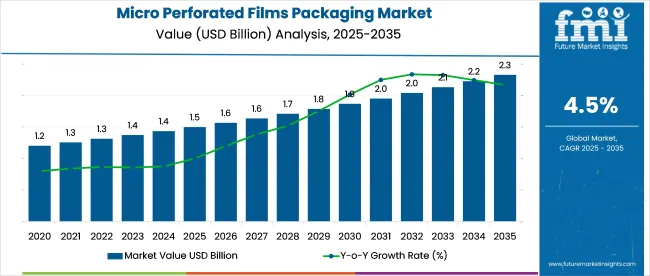
| Metric | Value |
|---|---|
| Estimated Value in (2025E) | USD 3.8 billion |
| Forecast Value in (2035F) | USD 8.7 billion |
| Forecast CAGR (2025 to 2035) | 8.6% |
Market expansion is being supported by the increasing global demand for fresh produce and the corresponding need for high-performance packaging materials that can extend shelf life, reduce food waste, and provide optimal respiration control across various fresh food categories. Modern food retailers are increasingly focused on implementing packaging solutions that can support extended distribution networks, enhance product presentation, and provide consistent freshness in demanding retail environments. Micro perforated films' proven ability to deliver exceptional gas exchange management, moisture control, and product visibility make them essential materials for contemporary fresh produce packaging and perishable food distribution solutions.
The growing emphasis on food waste reduction and fresh food quality is driving demand for micro perforated films that can support optimized respiration rates, prevent condensation buildup, and enable natural ripening processes during distribution and storage. Retailers' preference for packaging materials that combine functional performance with processing efficiency and design flexibility is creating opportunities for innovative micro perforated film implementations. The rising influence of fresh food e-commerce and organic produce distribution is also contributing to increased demand for micro perforated films that can provide controlled atmosphere conditions, product protection, and visual appeal functions.
The micro perforated films packaging market is poised for rapid growth and transformation. As industries across fresh produce, baked goods, floriculture, processed foods, and ready-to-eat meals seek packaging materials that deliver exceptional freshness preservation, respiration control, and food waste reduction advantages, micro perforated films are gaining prominence not just as commodity packaging materials but as strategic enablers of supply chain optimization and product quality enhancement.
Rising fresh produce consumption in Asia-Pacific and expanding organic food distribution globally amplify demand, while packaging converters are leveraging innovations in laser perforation technologies, intelligent hole pattern design, and biodegradable film substrate development.
Pathways like application-specific perforation optimization, advanced film substrate materials, and e-commerce packaging solutions promise strong margin uplift, especially in high-value segments. Geographic expansion and vertical integration will capture volume, particularly where local fresh food distribution capabilities and cold chain infrastructure are critical. Regulatory pressures around food waste reduction, plastic recycling, environmental impact, and fresh food safety give structural support.
The market is segmented by material type, application, perforation technology, end use, film thickness, and region. By material type, the market is divided into polyethylene (LDPE/LLDPE), polypropylene (PP), polyamide (PA), biodegradable polymers, and others. By application, it covers fresh produce packaging, bakery products, floriculture, ready-to-eat meals, and others. By perforation technology, it is segmented into laser perforation, mechanical perforation, and hot needle perforation. The end use includes retail, food service, export & distribution, and e-commerce. Based on film thickness, the market is categorized into thin films (15-40 microns), standard films (40-80 microns), and thick films (>80 microns). By distribution channel, the market includes direct sales, packaging distributors, and online platforms. Regionally, the market is divided into North America, Europe, East Asia, South Asia & Pacific, Latin America, and the Middle East & Africa.
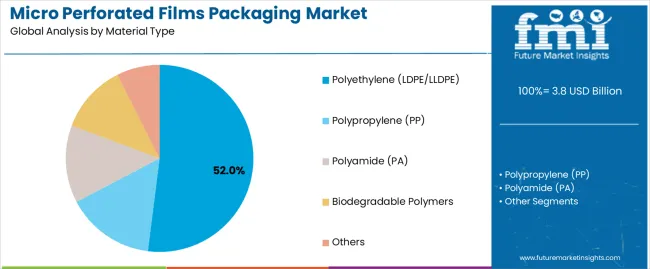
The polyethylene films segment is projected to account for 52% of the micro perforated films packaging market in 2025, reaffirming its position as the leading material category. Fresh produce packagers increasingly utilize polyethylene films for their superior moisture barrier properties, excellent processability, and cost-effectiveness in applications ranging from vegetable packaging to fruit distribution bags. Polyethylene film technology's advanced sealing capabilities and consistent quality output directly address the retail requirements for reliable performance and operational efficiency in high-volume fresh food packaging environments.
This material segment forms the foundation of modern fresh produce packaging operations, as it represents the film type with the greatest versatility and established market demand across multiple application categories and retail formats. Converter investments in enhanced perforation technologies and surface treatment capabilities continue to strengthen adoption among fresh produce distributors. With retailers prioritizing product visibility and freshness retention, polyethylene films align with both functional performance requirements and cost optimization objectives, making them the central component of comprehensive fresh food packaging strategies.
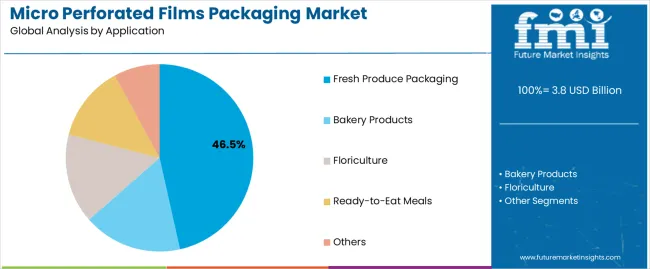
Fresh produce packaging applications are projected to represent 46.5% of micro perforated film demand in 2025, underscoring their critical role as the primary application consumers of breathable packaging materials for fruits, vegetables, and fresh herbs distribution. Produce distributors prefer micro perforated films for their exceptional respiration control properties, condensation prevention capabilities, and ability to extend shelf life while maintaining product quality. Positioned as essential materials for modern fresh produce supply chains, micro perforated films offer both freshness preservation advantages and supply chain efficiency benefits.
The segment is supported by continuous innovation in perforation pattern design and the growing availability of specialized laser perforation processes that enable optimized film production with precise hole sizing and distribution characteristics. Additionally, fresh produce distributors are investing in cold chain partnerships to support large-volume packaging operations and quality maintenance. As organic produce demand becomes more prevalent and food waste reduction requirements increase, fresh produce packaging applications will continue to dominate the end-use market while supporting advanced packaging innovation and supply chain optimization strategies.
The micro perforated films packaging market is advancing rapidly due to increasing demand for extended shelf life solutions and growing adoption of high-performance packaging materials that provide optimal gas exchange and moisture management across diverse fresh food applications. However, the market faces challenges, including raw material price fluctuations, technical complexity of perforation optimization for different produce types, and the need for specialized laser perforation equipment investments. Innovation in biodegradable film substrates and intelligent perforation design continues to influence product development and market expansion patterns.
The growing adoption of CO2 laser systems, UV laser perforation, and inline laser processing is enabling packaging converters to produce micro perforated films with superior hole consistency, precise size control, and optimized distribution patterns. Advanced laser perforation systems provide improved packaging performance while allowing more efficient production and consistent output across various film substrates and application requirements. Converters are increasingly recognizing the competitive advantages of laser perforation capabilities for product differentiation and premium market positioning.
Modern micro perforated film producers are incorporating ethylene absorbers, antimicrobial treatments, and freshness indicator integration to enhance packaging functionality, enable extended shelf life, and deliver value-added solutions to food retailers. These technologies improve produce quality retention while enabling new market segments, including premium organic packaging, export-grade produce bags, and intelligent fresh food packaging systems. Advanced functional integration also allows converters to support premium product positioning and application development beyond traditional passive breathable film supply.
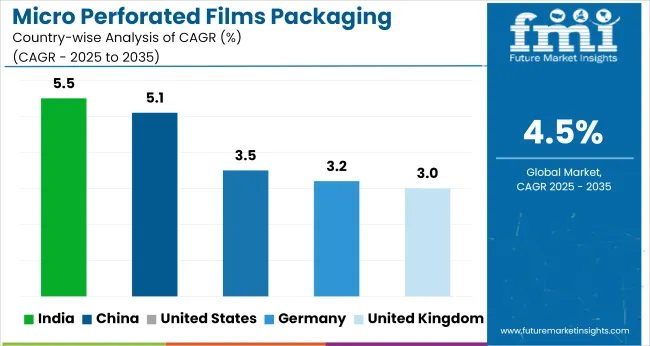
| Country | CAGR (2025-2035) |
|---|---|
| India | 11.2% |
| China | 10.6% |
| USA | 7.9% |
| Netherlands | 8.7% |
| Spain | 8.3% |
| Mexico | 9.4% |
| Germany | 7.1% |
The micro perforated films packaging market is experiencing strong growth globally, with India leading at an 11.2% CAGR through 2035, driven by the expanding fresh produce retail sector, growing organized food retail penetration, and significant investment in cold chain infrastructure development. China follows at 10.6%, supported by rapid fresh food e-commerce growth, increasing consumer demand for packaged produce, and growing domestic packaging converter capabilities. The USA shows growth at 7.9%, emphasizing organic produce distribution and advanced perforation technology innovation. The Netherlands records 8.7%, focusing on export floriculture applications and greenhouse produce packaging. Spain demonstrates 8.3% growth, prioritizing fresh produce export capabilities and Mediterranean fruit distribution. Mexico shows 9.4% growth, supported by fresh produce export to North America and growing domestic retail development. Germany exhibits 7.1% growth, emphasizing quality packaging standards and precision perforation production.
The report covers an in-depth analysis of 40+ countries top-performing countries are highlighted below.
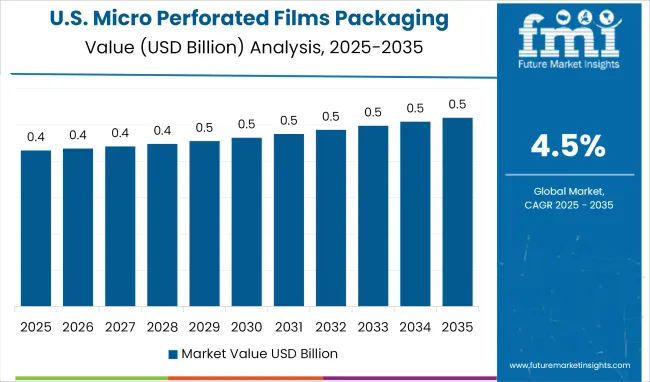
Revenue from micro perforated films packaging in India is projected to exhibit exceptional growth with a CAGR of 11.2% through 2035, driven by expanding organized retail penetration and rapidly growing fresh produce consumption supported by rising middle-class incomes and changing dietary preferences. The country's accelerating investment in cold chain infrastructure and increasing adoption of modern packaging technologies are creating substantial demand for high-performance breathable film solutions. Major retail chains and fresh produce distributors are establishing comprehensive micro perforated film sourcing capabilities to serve both domestic retail operations and export markets.
Revenue from micro perforated films packaging in China is expanding at a CAGR of 10.6%, supported by the country's booming fresh food e-commerce sector, expanding urban consumption of packaged produce, and increasing domestic converter capabilities. The country's sophisticated cold chain logistics networks and growing consumer quality expectations are driving requirements for advanced breathable packaging capabilities. International suppliers and domestic converters are establishing extensive production and distribution capabilities to address the growing demand for micro perforated film products.
Revenue from micro perforated films packaging in the USA is expanding at a CAGR of 7.9%, supported by the country's extensive organic produce distribution networks, strong emphasis on food waste reduction initiatives, and robust demand for premium fresh food packaging in retail and food service channels. The nation's mature fresh produce supply chains and quality-focused retail sector are driving sophisticated micro perforated film capabilities throughout packaging converters. Leading retailers and produce distributors are investing extensively in advanced laser perforation technologies and application-specific film development to serve both domestic consumption and export markets.
Revenue from micro perforated films packaging in the Netherlands is growing at a CAGR of 8.7%, driven by the country's leadership in flower export operations, expanding greenhouse produce distribution, and growing investment in precision perforation technologies. The Netherlands' concentration of advanced horticultural operations and commitment to packaging innovation are supporting demand for specialized micro perforated film solutions across high-value fresh product segments. Packaging converters are establishing comprehensive research and production capabilities to maintain technological leadership in floriculture and premium produce applications.
Revenue from micro perforated films packaging in Spain is expanding at a CAGR of 8.3%, supported by the country's strong position in European fresh produce supply, advanced fruit export capabilities, and strategic focus on Mediterranean product packaging. Spain's established citrus, berry, and vegetable export operations are driving demand for micro perforated films in premium fruit packaging, salad bag applications, and stone fruit distribution systems. Converters are investing in comprehensive perforation optimization capabilities to serve both domestic retail markets and European export channels.
Revenue from micro perforated films packaging in Mexico is growing at a CAGR of 9.4%, driven by the country's strategic position in North American fresh produce supply chains, expanding avocado and berry exports, and growing investment in modern packaging infrastructure. Mexico's established agricultural export operations and proximity to major consumption markets are supporting demand for high-quality micro perforated films in export-grade packaging applications. Converters are establishing advanced production capabilities to serve stringent quality requirements of North American retail customers.
Revenue from micro perforated films packaging in Germany is growing at a CAGR of 7.1%, driven by the country's emphasis on packaging quality standards, precision perforation manufacturing, and strong position in organic produce distribution. Germany's established retail quality requirements and commitment to packaging innovation are supporting investment in advanced laser perforation technologies throughout major converting centers. Industry leaders are establishing comprehensive quality management systems to serve domestic organic retailers and European specialty markets.

The micro perforated films packaging market in Europe is projected to grow from USD 1.1 billion in 2025 to USD 2.4 billion by 2035, registering a CAGR of 8.1% over the forecast period. The Netherlands is expected to maintain its leadership position with a 24.0% market share in 2025, increasing slightly to 24.5% by 2035, supported by its dominant floriculture export operations, advanced greenhouse produce packaging capabilities, and comprehensive fresh product distribution infrastructure serving European markets.
Spain follows with a 21.0% share in 2025, projected to reach 21.5% by 2035, driven by robust demand for micro perforated films in citrus packaging, berry distribution, and Mediterranean produce export operations, combined with established converter capabilities and fresh produce supply chain expertise. Germany holds an 18.0% share in 2025, expected to reach 18.5% by 2035, supported by strong organic produce retail presence and quality-focused packaging standards. France commands a 14.0% share in 2025, projected to reach 14.2% by 2035, while the United Kingdom accounts for 10.0% in 2025, expected to reach 10.0% by 2035. Italy maintains a 7.5% share in 2025, growing to 7.8% by 2035. The Rest of Europe region, including Nordic countries, Eastern Europe, Belgium, Poland, and Portugal, is anticipated to gain momentum, expanding its collective share from 5.5% to 3.5% by 2035, attributed to increasing modern retail penetration in Eastern Europe and growing greenhouse cultivation operations in Nordic countries implementing advanced fresh produce packaging programs.

The microperforated films packaging market features 10–15 players with moderate concentration, where the top three companies collectively hold around 42–48% of global market share. Growth is driven by rising demand for breathable packaging in fresh produce, bakery, ready-to-eat meals, and industrial applications. The leading company, Amcor plc, commands roughly 7% market share, supported by its advanced laser micro-perforation technologies, strong sustainability initiatives, and global converting footprint. Competition centers on perforation precision, moisture/oxygen transmission control, film strength, and compatibility with high-speed packaging lines rather than price alone.
Market leaders such as Amcor plc, Mondi Group, and Uflex Limited maintain dominant positions through high-performance PE, PP, and PET micro-perforated films engineered to extend freshness, reduce condensation, and optimize modified-atmosphere packaging. Their strengths include multilayer film innovation, tight perforation uniformity, and tailored barrier performance for specific food categories.
Challenger companies including Coveris Holdings S.A., Sealed Air Corporation, and Berry Global Inc. focus on specialized breathable films for produce and bakery applications, emphasizing lightweighting, sustainability, and custom perforation patterns.
Additional competitive pressure arises from regional and niche producers such as NOW Plastics, Helion Industries, Agropack, and P+ Films, which strengthen their market presence through cost-effective production, agile customization, and localized supply for agricultural, retail, and industrial clients.
| Items | Values |
|---|---|
| Quantitative Units (2025) | USD 3.8 billion |
| Material Type | Polyethylene (LDPE/LLDPE), Polypropylene (PP), Polyamide (PA), Biodegradable Polymers, Others |
| Application | Fresh Produce Packaging, Bakery Products, Floriculture, Ready-to-Eat Meals, Others |
| Perforation Technology | Laser Perforation, Mechanical Perforation, Hot Needle Perforation |
| End Use | Retail, Food Service, Export & Distribution, E-commerce |
| Film Thickness | Thin Films (15-40 microns), Standard Films (40-80 microns), Thick Films (>80 microns) |
| Distribution Channel | Direct Sales, Packaging Distributors, Online Platforms |
| Regions Covered | North America, Europe, East Asia, South Asia & Pacific, Latin America, Middle East & Africa |
| Countries Covered | United States, Canada, United Kingdom, Germany, France, Spain, Netherlands, China, Japan, South Korea, India, Mexico, Brazil, Australia and 40+ countries |
| Key Companies Profiled | Amcor plc, Mondi Group, Uflex Limited, Coveris Holdings S.A., Sealed Air Corporation, Berry Global Inc., NOW Plastics, Helion Industries, Agropack, and P+ Films |
| Additional Attributes | Dollar sales by material type and application category, regional demand trends, competitive landscape, technological advancements in laser perforation systems, biodegradable film development, active packaging integration, and supply chain optimization |
The global micro perforated films packaging market is estimated to be valued at USD 3.8 billion in 2025.
The market size for the micro perforated films packaging market is projected to reach USD 8.7 billion by 2035.
The micro perforated films packaging market is expected to grow at a 8.6% CAGR between 2025 and 2035.
The key product types in micro perforated films packaging market are polyethylene (ldpe/lldpe), polypropylene (pp), polyamide (pa), biodegradable polymers and others.
In terms of application, fresh produce packaging segment to command 46.5% share in the micro perforated films packaging market in 2025.






Our Research Products

The "Full Research Suite" delivers actionable market intel, deep dives on markets or technologies, so clients act faster, cut risk, and unlock growth.

The Leaderboard benchmarks and ranks top vendors, classifying them as Established Leaders, Leading Challengers, or Disruptors & Challengers.

Locates where complements amplify value and substitutes erode it, forecasting net impact by horizon

We deliver granular, decision-grade intel: market sizing, 5-year forecasts, pricing, adoption, usage, revenue, and operational KPIs—plus competitor tracking, regulation, and value chains—across 60 countries broadly.

Spot the shifts before they hit your P&L. We track inflection points, adoption curves, pricing moves, and ecosystem plays to show where demand is heading, why it is changing, and what to do next across high-growth markets and disruptive tech

Real-time reads of user behavior. We track shifting priorities, perceptions of today’s and next-gen services, and provider experience, then pace how fast tech moves from trial to adoption, blending buyer, consumer, and channel inputs with social signals (#WhySwitch, #UX).

Partner with our analyst team to build a custom report designed around your business priorities. From analysing market trends to assessing competitors or crafting bespoke datasets, we tailor insights to your needs.
Supplier Intelligence
Discovery & Profiling
Capacity & Footprint
Performance & Risk
Compliance & Governance
Commercial Readiness
Who Supplies Whom
Scorecards & Shortlists
Playbooks & Docs
Category Intelligence
Definition & Scope
Demand & Use Cases
Cost Drivers
Market Structure
Supply Chain Map
Trade & Policy
Operating Norms
Deliverables
Buyer Intelligence
Account Basics
Spend & Scope
Procurement Model
Vendor Requirements
Terms & Policies
Entry Strategy
Pain Points & Triggers
Outputs
Pricing Analysis
Benchmarks
Trends
Should-Cost
Indexation
Landed Cost
Commercial Terms
Deliverables
Brand Analysis
Positioning & Value Prop
Share & Presence
Customer Evidence
Go-to-Market
Digital & Reputation
Compliance & Trust
KPIs & Gaps
Outputs
Full Research Suite comprises of:
Market outlook & trends analysis
Interviews & case studies
Strategic recommendations
Vendor profiles & capabilities analysis
5-year forecasts
8 regions and 60+ country-level data splits
Market segment data splits
12 months of continuous data updates
DELIVERED AS:
PDF EXCEL ONLINE
Market Share Breakdown of Micro Perforated Films Packaging Manufacturers
Micro-perforated Food Packaging Market Size and Share Forecast Outlook 2025 to 2035
Packaging Films Market Size and Share Forecast Outlook 2025 to 2035
Market Share Distribution Among Packaging Films Suppliers
Perforated Packaging Market - Growth & Demand 2025 to 2035
Micro-Scale Packaging Machines Market Analysis Size and Share Forecast Outlook 2025 to 2035
Antimicrobial Packaging Ingredients for Food Packaging Market Size and Share Forecast Outlook 2025 to 2035
Competitive Overview of Antimicrobial Packaging Ingredients for Food Packaging
Antimicrobial Packaging Market
Food Packaging Films Market Size and Share Forecast Outlook 2025 to 2035
MOPP Packaging Films Market Insights - Growth & Forecast 2025 to 2035
Meat Packaging Films Market
Microwavable Barrier Films Market Size and Share Forecast Outlook 2025 to 2035
BOPET Packaging Films Market Size and Share Forecast Outlook 2025 to 2035
Medical Packaging Films Market Size and Share Forecast Outlook 2025 to 2035
Hygiene Packaging Films Market Size and Share Forecast Outlook 2025 to 2035
Antifog Packaging Films Market Trends – Growth & Forecast 2025-2035
Antimicrobial Polymer Films Market Insights – Growth & Forecast 2024-2034
Anti-Microbial Edible Packaging Market Analysis - Size, Share, and Forecast Outlook 2025 to 2035
Nylon Films for Liquid Packaging Market from 2024 to 2034

Thank you!
You will receive an email from our Business Development Manager. Please be sure to check your SPAM/JUNK folder too.
Chat With
MaRIA